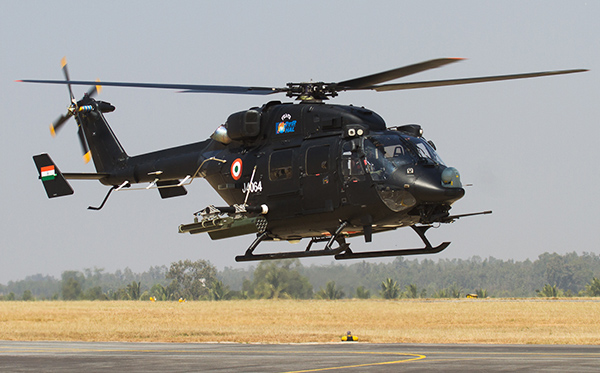
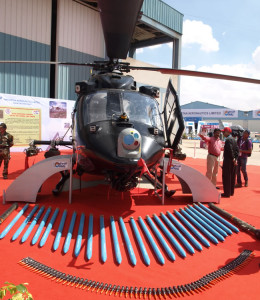
Hindustan Aeronautics Ltd. (HAL) has received the initial operational clearance (IOC) for its Advanced Light Helicopter Mk.IV-WSI named as the ‘Rudra’. Dr. K. Tamilmani, CEO, Centre for Military Airworthiness and Certification (CEMILAC) presented the certificate to HAL at a function in Bangalore last week. Speaking on the occasion, Dr. Tamilmani stresses that potential for helicopters in India remains ‘massive’ and the country has the ability to meet technical challenges on this front.
Mr. P. Soundara Rajan, Managing Director of HAL Helicopter Complex, stated that integration of multiple weapon systems simultaneously is a complicated task. “In this particular case it involved four major groups of systems and weapons, involving eight countries: Israel, France, Belgium, South Africa, Germany, Italy, USA and India. Nearly 23 kilometers of cables had been laid and hundreds of hours in flight and ground tests were carried out.” The Indian Army has already received considerable numbers of the Advanced Light Helicopter (ALH), most of it being Mk.IIIs which are formed into a number of utility helicopter squadrons, deployed in various operational areas in northern and eastern India, including at very high altitude bases in Ladakh. The Mk.IV Rudra will endow major strike power to formations on the western borders.
 The helicopter on display here at Aero-India 2013 displays the entire weapon mix currently configured for the platform. This armament is currently limited to a chin-mounted Nexter 20mm M621 cannon mounted onto a THL 20 turret, 70mm rockets in four pods and four MBDA Mistral short-range air/air missiles. The Helicopter will carry up to eight anti-tank missiles – the Helicopter NAG (HELINA) missiles are planned. These weapons have been selected for the helicopter as a typical ‘arranged marriage’, when both platform and missile were too young and premature do decide upon. While the ALH has grown up and matured, NAG still lags behind and the Indian Army will have to take a decision soon, if it continues to commit to HELINA or move to one of the alternatives currently awaiting decision – PARS 3LR from MBDA or Spike ER from Rafael.
The helicopter on display here at Aero-India 2013 displays the entire weapon mix currently configured for the platform. This armament is currently limited to a chin-mounted Nexter 20mm M621 cannon mounted onto a THL 20 turret, 70mm rockets in four pods and four MBDA Mistral short-range air/air missiles. The Helicopter will carry up to eight anti-tank missiles – the Helicopter NAG (HELINA) missiles are planned. These weapons have been selected for the helicopter as a typical ‘arranged marriage’, when both platform and missile were too young and premature do decide upon. While the ALH has grown up and matured, NAG still lags behind and the Indian Army will have to take a decision soon, if it continues to commit to HELINA or move to one of the alternatives currently awaiting decision – PARS 3LR from MBDA or Spike ER from Rafael.
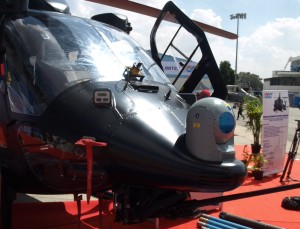
The cockpit represents an advanced glass-cockpit layout, with large area multiple MFDs and helmet displays. Mounted over the beek-like nose is the stabilized multi-sensor COMPASS payload, providing the crew the imagery necessary for reconnaissance and target acquisition. COMPASS, developed by Elbit Systems, incorporates daylight and thermal cameras with powerful zoom, and three different lasers – a rangefinder, target designator and IR laser pointer, assisting in covert air/ground coordination.
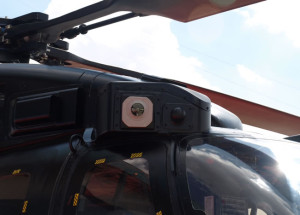
The helicopter is fitted with an integrated defensive aids system (IDAS-3) from SAAB, which delivered the system’s components while the aircraft integration was provided by HAL. IDAS-3 utilizes UV missile approach warning sensors, LWS-310 laser warning sensors and RWS-300 radar warning receivers and flare dispensers. Two units are clearly visible on the upper cockpit sides.
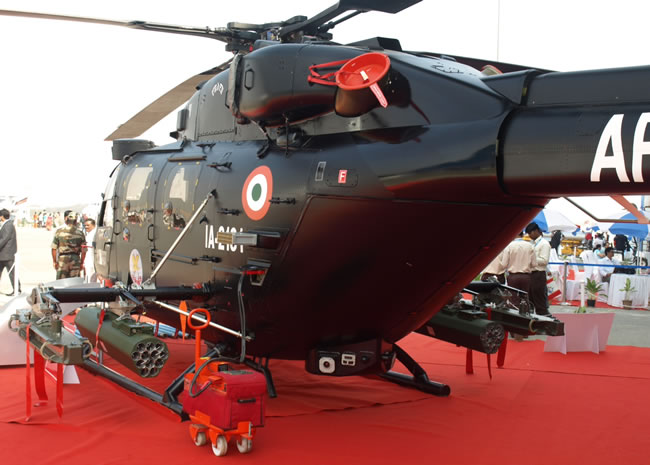
For more photos check this gallery at: Livefist.




















